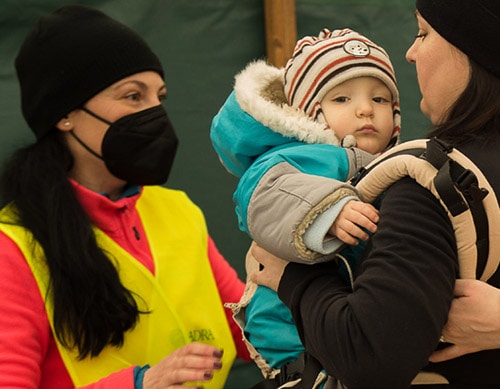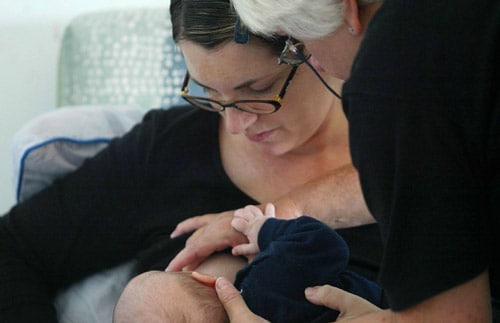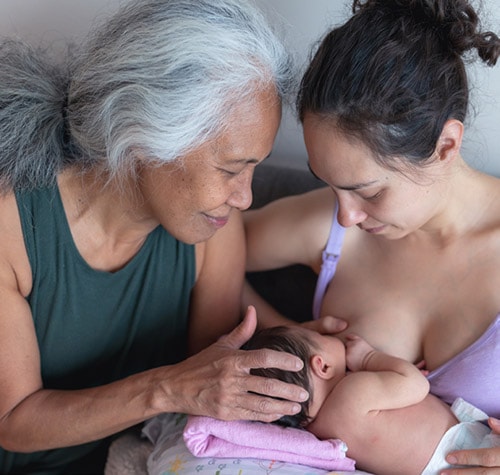Response

If you are an emergency relief worker consider the following:
Identify Resource Needs
- Document the number of pregnant women and families with children under the age of 2 years and how they are fed to determine resources needed.
- Conduct a rapid needs assessment:
- A rapid needs assessment that includes infant and young child feeding questions can help to ensure feeding needs (supplies and support) can be appropriately addressed.
- A rapid environmental health assessment of shelter conditions can help to identify and document other immediate needs in the shelter, including safe areas for children and families.
Create a Safe Space for All Families
Emergency situations can be very stressful and traumatic. It is important to help families feel safe and supported to provide adequate food and water for their children.
- Keep families together.
- Reassure breastfeeding women that they can and should continue to breastfeed and offer the breast as often as their infants want.
- Consider grouping families with infants and young children together to encourage mutual aid and support resiliency.
It’s All About Access
- Make pregnant, postpartum, and lactating women one priority group for access to food and water, shelter, healthcare, protection, psychosocial support, or other essential support. Pregnant, postpartum, and lactating women should be provided with food and water to meet the additional caloric intake needed for their bodies to optimally support pregnancy or lactation.
- Be ready to connect parents and caregivers to lactation support providers if they need help.
- Coordinate care for families needing referrals to appropriate psychological first aid and/or mental health and psychosocial support providers and resources.
Cleanliness is Key
- For infants who are not breastfeeding or being fed breast milk, ready-to-feed (RTF) infant formula is safest. Powdered infant formula is not sterile and thus, must be carefully prepared and stored properly.
- Make disposable cups available, since bottles and nipples are hard to clean effectively when there is limited access to clean water.
- Make disposable bibs, plates, bowls, and utensils available for feeding children.
- Provide antibacterial cleansing wipes for families to clean surfaces before and after feeding their children.
- If there is safe water, ensure access to cleaning items such as washbasin, dish soap, cleaning brushes, and a mesh bag to hang dry infant and toddler feeding items. Educate families about how to clean infant feeding items.
- For families who rely on a breast pump, ensure access to safe water and cleaning items like a washbasin, dish soap, cleaning brushes, and a mesh bag to hang dry breast pump kit parts.
- Educate families about safe storage and preparation of breast milk considering available resources (e.g., refrigeration).
- Provide education to families about where and how to properly clean breast pump kits while they are in the shelter setting.
Education is Essential

- Talk to breastfeeding women about the importance of continuing to give breast milk to their child during and after the emergency.
- Breastfeeding infants under 6 months of age require no water supplementation, even in extreme heat environments.
- With the support of a lactation provider, mothers who are partially breastfeeding their child can breastfeed more frequently to increase milk supply and decrease reliance on infant formula.
- A request for infant formula from a parent does not necessarily indicate an actual need for infant formula. Some families may be worried about having enough breast milk for their child and request infant formula to supplement. When these families request formula, a rapid needs assessment can help to identify feeding support, education, and resources that might be needed to support continued breastfeeding and ensure the child is receiving adequate nutrition.
- Teach women who rely on a breast pump how to safely store their milk and how to properly clean breast pump kits and infant feeding items. It is important to provide education that takes into consideration the immediate available resources (e.g., refrigeration, safe water, cleaning supplies, heat source).
- If appropriate, inform women who had breastfeeding interrupted, or who previously breastfed, but currently feed infant formula, that they may be able to relactate to provide their child with their milk. Connect them to a lactation support provider for relactation support if they are interested in working to relactate.
- If RTF infant formula is not available for formula feeding families, teach families how to safely prepare and feed powdered infant formula in an emergency setting. Even though these families may have prior experience preparing and feeding powdered infant formula, there are risks in emergency situations that require additional precautions.
- The provision of infant formula during an emergency should include support and education to ensure safe preparation and handling. Education and support can include:
- individualized, context-specific advice,
- practical training on safe preparation of powdered infant formula (if RTF infant formula is not available),
- practical training on feeding infants from a cup,
- practical training on cleaning infant feeding items such as cups, or bottles and nipples (if disposable cups are not available),
- provision of equipment and supplies to safely store, prepare, and feed infant formula and clean all non-disposable infant feeding items, and
- regular follow-up with families, in coordination with other emergency responders.
- When children start eating solid foods, they start out with smooth or mashed foods and then begin to eat finely chopped or ground foods as they get older. Provide families whose children are eating solid foods with information on where to prepare foods for their children. Provide preparation materials (e.g., utensils, a blender) to mash or chop foods as needed.
Key Things to Consider
- DO NOT include infant formula in infant/toddler kits, household packages or other general distributions. Infant formula should not be located in areas where other foods are freely available or being distributed or served.
- DO: have a trained health or nutrition worker provide these on a case-by-case basis following a rapid needs assessment.
- DO: provide RTF infant formula to infants who are already formula feeding or have had breastfeeding interrupted in certain situations (if donor milk is unavailable).
- DO: Store infant formula in a location out of public view; this will help ensure that it is appropriately distributed along with information about how to safely prepare it.
- DO NOT call for, accept, or distribute donations of manual or electric breast pumps. Without power, mothers or caregivers cannot use an electric breast pump or safely refrigerate their expressed milk. Furthermore, keeping pump parts clean is an additional challenge when the water is unsafe.
- DO: For families that rely on a breast pump to feed their infants, encourage them to breastfeed at the breast more and/or hand express their milk for feedings. If this is not possible, make sure they have access to electricity and/or batteries to operate the pump, and a refrigerator to store their milk. These families also need access to safe water and cleaning supplies to properly clean the pump part kits after every use. If proper cleaning of breast pumps is not possible, they should not be used, and hand expression should be prioritized.
- DO NOT call for, accept, or distribute donations of infant formula or toddler milks. Emergency supplies of infant formula are managed and provided by official relief organizations. It’s important for relief organizations to manage the process of getting and distributing infant formula so that they can make sure it is stored at a safe temperature and given only to families that need it. They will also make sure that families get the information and supplies they need to feed their babies safely. Learn more about formula donations.
- DO NOT call for, accept, or distribute donations of reusable feeding equipment (such as feeding bottles and nipples) and pacifiers.
- DO: Conduct an infant feeding rapid needs assessment. These items should only be given to families following an assessment that determines need, confirmation that there is a safe way to properly clean these items, and education on how to properly clean these items during the emergency.

Key Areas for Action
- Actively support breastfeeding by putting written guidelines in place.
- Make sure that all volunteers and relief workers are trained to support infant and young child feeding.
- Provide appropriate safe feeding information to families who give their infants infant formula.
- Provide education to families about safe complementary feeding.
- Prevent donations and uncontrolled distribution of infant formula and other products, such as infant feeding items that need cleaning and that might not be safe during or following an emergency.
- Support maternal wellbeing by providing access to mental health resources and providers.
- Target support to high-risk infants, children, and their caregivers who are identified during the rapid needs assessment.
View Page In: PDF-6.0MB
Error processing SSI file
Page last reviewed: September 13, 2022
